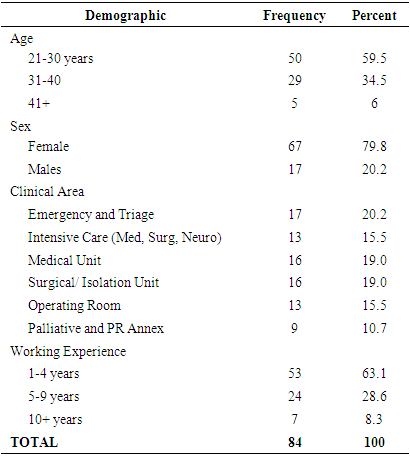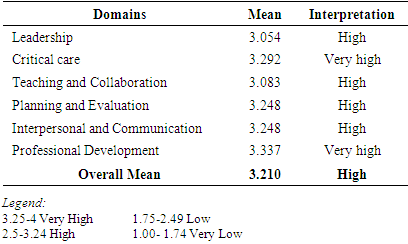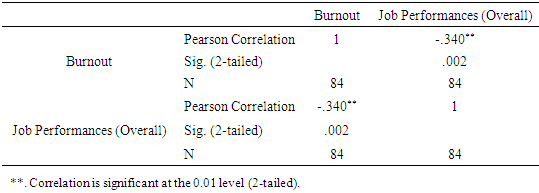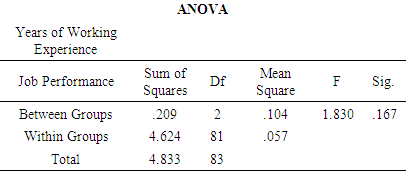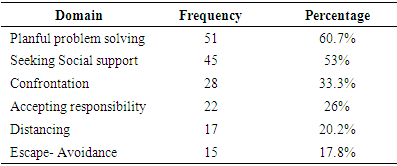| [1] | Abdelhafiz, A. S., Ali, A., Ziady, H. H., Maaly, A. M., Alorabi, M., & Sultan, E. A. (2020). Prevalence, associated factors, and consequences of burnout among Egyptian physicians during COVID-19 pandemic. Frontiers in public health, 8, 864. https://doi.org/10.3389/fpubh.2020.590190. |
| [2] | Abdullah, D. N. M. A., & Yuen, F. C. (2011). The impact of job burnout on job performance among nurses. 2011 IEEE Symposium on Business, Engineering, and Industrial Applications (ISBELA). https://doi.org/101109/isbeia.2011.6088836. |
| [3] | Abi Hussein, F. (2019). The Impact of Performance Obstacles on Workload and Quality of Working Life Among Critical Care Nurses in Lebanon. http://repository.bau.edu.lb:8080/xmlui/handle/1080/9010. |
| [4] | Abravani, P., & Gharibzadeh, S. (2020). Coping strategies during COVID-19 outbreak in Islamic Republic of Iran. Journal of Experimental and Clinical Neurosciences, 7(2). https://doi.org/10.13183/jecns.v7i2.118. |
| [5] | Al Sabei, S. D., Labrague, L. J., Miner, A., Karkada, S., Albashayreh, A., Al Masroori, F., & Al Hashmi, N. (2019). Nursing work environment, turnover intention, job burnout, and quality of care: The moderating role of job satisfaction. Journal of Nursing Scholarship, 52(1), 95-104. https://doi.org/10.1111/jnu.12528. |
| [6] | Ali, H., Astin Cole, A. A., & Sa’d Hamasha, G. P. (2020). Major stressors and coping strategies of frontline nursing staff during the outbreak of coronavirus disease 2020 (COVID-19) in Alabama. Journal of Multidisciplinary Healthcare, 13, 2057. https://dx.doi.org/10.2147%2FJMDH.S285933. |
| [7] | AlJhani, S., AlHarbi, H., AlJameli, S., Hameed, L., AlAql, K., & Alsulaimi, M. (2021). Burnout and coping among healthcare providers working in Saudi Arabia during the COVID-19 pandemic. Middle East Current Psychiatry, 28(1), 1-14. https://doi.org/10.1186/s43045-021-00108-6. |
| [8] | Al-Makhaita, H., M., Sabra, A. A., & Hafez, A. S. (2014). Job performance among nurses working in two different health care levels, Eastern Saudi Arabia: a comparative study. International Journal of Medical Science and Public Health, 3(7), 832-837. Https://doi.org/10.5455/ijmsph.2014.240420142. |
| [9] | Apex-Apeh, C., O., Ujoatuonu, I. V., Ugwu, J. I., & Olowu, C. T. (2020). Motivation and work environment as predictors of job performance among nurses. Nigerian Journal of Psychological Research, 16(1). |
| [10] | Baloran, E. T. (2020). Knowledge, attitudes, anxiety, and coping strategies of students during COVID-19 pandemic. Journal of loss and trauma, 25(8), 635-642. https://doi.org/10.1080/15325024.2020.1769300. |
| [11] | Bender, A. E., Berg, K. A., Miller, E. K., Evans, K. E., & Holmes, M. R. (2021). “Making sure we are all okay”: Healthcare workers’ strategies for emotional connectedness during the COVID-19 pandemic. Clinical Social Work Journal, 1-11. https://doi.org/10.1007/s10615-020-00781-w. |
| [12] | Chen, J., Li, J., Cao, B., Wang, F., Luo, L., & Xu, J. (2020). Mediating effects of self‐efficacy, coping, burnout, and social support between job stress and mental health among young Chinese nurses. Journal of Advanced Nursing, 76(1), 163-173. https://doi.org/10.1111/jan.14208. |
| [13] | Cho, H., & Han, K. (2018). Associations among nursing work environment and health-promoting behaviors of nurses and nursing performance quality: A multilevel modeling approach. Journal of Nursing Scholarship, 50(4), 403-410. https://doi.org/10.1111/jnu.12390. |
| [14] | Cui, S., Zhang, L., Yan, H., Shi, Q., Jiang, Y., Wang, Q., & Chu, J. (2020). Experiences and psychological adjustments of nurses who voluntarily supported COVID-19 patients in Hubei Province, China. Psychology Research and Behavior Management, 13, 1135. https://doi.org/10.2147/PRBM.S283876. |
| [15] | Del Castillo, F., & Alino, M. A. (2020). Religious coping of selected Filipino Catholic youth. Religions, 11(9), 462. https://doi.org/10.3390/rel11090462. |
| [16] | Dinibutun, S., R. (2020). Factors associated with burnout among physicians: an evaluation during a period of COVID-19 pandemic. Journal of healthcare leadership, 12, 85. https://dx.doi.org/10.2147%2FJHL.S270440. |
| [17] | Donaldson, L. J., Panesar, S. S., McAvoy, P. A., & Scarrott, D. M. (2014). Identification of poor performance in a national medical workforce over 11 years: an observational study. BMJ quality & safety, 23(2), 147-152. http://dx.doi.org/10.1136/bmjqs-2013-002054. |
| [18] | Duarte, I., Teixeira, A., Castro, L., Marina, S., Ribeiro, C., Jácome, C., ... & Serrão, C. (2020). Burnout among Portuguese healthcare workers during the COVID-19 pandemic. BMC public health, 20(1), 1-10. https://doi.org/10.1186/s12889-020-09980-z. |
| [19] | Dyrbye, L. N., Shanafelt, T. D., Johnson, P. O., Johnson, L. A., Satele, D., & West, C. P. (2019). A cross-sectional study exploring the relationship between burnout, absenteeism, and job performance among American nurses. BMC nursing, 18(1), 57. https://doi.org/10.1186/s12912-019-0382-7. |
| [20] | Eslami Akbar, R., Elahi, N., Mohammadi, E., & Fallahi Khoshknab, M. (2017). How do the nurses cope with job stress? A study with grounded theory approach. Journal of Caring Sciences, 6(3), 199-211. https://doi.org/10.15171/jcs.2017.020. |
| [21] | Fares, J., Al Tabosh, H., Saadeddin, Z., El Mouhayyar, C., & Aridi, H. (2016). Stress, burnout and coping strategies in preclinical medical students. North American Journal of Medical Sciences, 8(2), 75. https://doi.org/10.4103/1947-2714.177299. |
| [22] | Farhady, Y., Ashtari, Z., & Khodaee, M. (2009). Relationship between job burnout and work performance in a sample of Iranian mental health staff. African Journal of Psychiatry, 12(1). https://doi.org/10.4314/ajpsy.v12i1.30282. |
| [23] | Fasbender, U., Van der Heijden, B. I., & Grimshaw, S. (2019). Job satisfaction, job stress and nurses’ turnover intentions: The moderating roles of on-the-job and off-the-job embeddedness. Journal of advanced nursing, 75(2), 327-337. https://doi.org/10.1111/jan.13842. |
| [24] | Folkman S., Lazarus R., S. Coping as a mediator of emotion. Journal of Personality and Social Psychology. 1988; 54(3):466–475. https://doi.org/10.1037/0022-3514.54.3.466. |
| [25] | Freudenberger, H., J. (1974). undefined. Journal of Social Issues, 30(1), 159-165. https://doi.org/10.1111/j.1540-4560.1974.tb00706.x. |
| [26] | Fujino, Y., Tanaka, M., Yonemitsu, Y., & Kawamoto, R. (2015). The relationship between characteristics of nursing performance and years of experience in nurses with high emotional intelligence. International journal of nursing practice, 21(6), 876-881. https://doi.org/10.1111/ijn.12311. |
| [27] | Gozum, I. E. A. (2020). The filipino family in the formation of values in the light of John Paul II’s familiaris consortio. Φιλοσοφια: International Journal of Philosophy, 21(Special Edition), 1-1. |
| [28] | Hall, L. H., Johnson, J., Watt, I., Tsipa, A., & O’Connor, D. B. (2016). Healthcare staff wellbeing, burnout, and patient safety: a systematic review. PloS one, 11(7), e0159015. https://doi.org/10.1371/journal.pone.0159015. |
| [29] | Hoff, T., Carabetta, S., & Collinson, G. E. (2019). Satisfaction, burnout, and turnover among nurse practitioners and physician assistants: a review of the empirical literature. Medical Care Research and Review, 76(1), 3-31. https://doi.org/10.1177/1077558717730157. |
| [30] | Hosseini, M., Sedghi Goyaghaj, N., Alamadarloo, A., Farzadmehr, M., & Mousavi, A. (2017). The relationship between job burnout and job performance of clinical nurses in Shiraz Shahid Rajaei hospital (thruma) in 2016. Journal of clinical nursing and midwifery, 6(2), 59-68. http://jcnm.skums.ac.ir/article-1-596-en.html. |
| [31] | Hu, D., Kong, Y., Li, W., Han, Q., Zhang, X., Zhu, L. X., Wan, S. W., Liu, Z., Shen, Q., Yang, J., He, H., & Zhu, J. (2020). Frontline nurses’ burnout, anxiety, depression, and fear statuses and their associated factors during the COVID-19 outbreak in Wuhan, China: A large-scale cross-sectional study. EClinicalMedicine, 24, 100424. https://doi.org/10.1016/j.eclinm.2020.100424. |
| [32] | Iheduru-Anderson, K. (2021). Reflections on the lived experience of working with limited personal protective equipment during the COVID‐19 crisis. Nursing inquiry, 28(1), e12382. https://doi.org/10.1111/nin.12382. |
| [33] | Johansen, M. L., de Cordova, P. B., & Weaver, S. H. (2021). Exploration of the Meaning of Healthy Work Environment for Nurses. Nurse Leader, 19(4), 383-389. https://doi.org/10.1016/j.mnl.2020.06.011. |
| [34] | Kahambing, J. G., & Edilo, S. R. (2020). Stigma, exclusion, and mental health during COVID19: 2 cases from the Philippines. Asian Journal of Psychiatry, 54, 102292. https://doi.org/10.1016/j.ajp.2020.102292. |
| [35] | Kaynak, R., Tuygun Toklu, A., Elci, M., & Tamer Toklu, I. (2016). Effects of occupational health and safety practices on organizational commitment, work alienation, and job performance: Using the PLS-SEM approach. International Journal of Business and Management, 11(5), 146. https://doi.org/10.5539/ijbm.v11n5p146. |
| [36] | Khan, B. A. (2020). Economic Impact of Covid-19 And Change in Value System. LC International Journal of STEM (ISSN: 2708-7123), 1(2), 23-31. https://doi.org/10.5281/zenodo.5010230. |
| [37] | Kim, H. S., & Yeom, H. (2018). The association between spiritual wellbeing and burnout in intensive care unit nurses: A descriptive study. Intensive and Critical Care Nursing, 46, 92-97. https://doi.org/10.1016/j.iccn.2017.11.005. |
| [38] | Kristensen, T. S., Borritz, M., Villadsen, E., & Christensen, K. B. (2005). The Copenhagen Burnout Inventory: A new tool for the assessment of burnout. Work & Stress, 19(3), 192-207. https://doi.org/ 10.1080/02678370500297720. |
| [39] | Labrague, L. J., & De los Santos, J. A. A. (2020). COVID-19 anxiety among frontline nurses: Predictive role of organisational support, personal resilience and social support. Journal of nursing management, 28(7), 1653-1661. https://doi.org/10.1111/jonm.13121. |
| [40] | Lee, H. S., & Yom, Y. H. (2015). Role of self-leadership and social support in the relationship between job embeddedness and job performance among general hospital nurses. Journal of Korean Academy of Nursing Administration, 21(4), 375-385. https://doi.org/10.11111/jkana.2015.21.4.375. |
| [41] | Liyew, B., Dejen Tilahun, A., & Kassew, T. (2020). Knowledge, attitude, and associated factors towards physical assessment among nurses working in intensive care units: A multicenter cross-sectional study. Critical Care Research and Practice, 2020. https://doi.org/10.1155/2020/9145105. |
| [42] | Lu, J. L. (2017). Burnout as a form of mental health problem among nurses in the Philippines. European Psychiatry, 41(S1), S338-S339. https://doi.org/10.1016/j.eurpsy.2017.02.295. |
| [43] | Luan, X., Wang, P., Hou, W., Chen, L., & Lou, F. (2017). Job stress and burnout: A comparative study of senior and head nurses in China. Nursing & health sciences, 19(2), 163-169. https://doi.org/10.1111/nhs.12328. |
| [44] | Luceño-Moreno, L., Talavera-Velasco, B., García-Albuerne, Y., & Martín-García, J. (2020). Symptoms of posttraumatic stress, anxiety, depression, levels of resilience and burnout in Spanish health personnel during the COVID-19 pandemic. International journal of environmental research and public health, 17(15), 5514. https://doi.org/10.3390/ijerph17155514. |
| [45] | Mahmoudi, S., Barkhordari-Sharifabad, M., Pishgooie, A., Atashzadeh-Shoorideh, F., & Lotfi, Z. (2020). Burnout among Iranian nurses: A national survey. BMC Nursing, 19(1). https://doi.org/10.1186/s12912-020-00461-7. |
| [46] | Mariani, R., Renzi, A., Di Trani, M., Trabucchi, G., Danskin, K., & Tambelli, R. (2020). The impact of coping strategies and perceived family support on depressive and anxious symptomatology during the coronavirus pandemic (COVID-19) lockdown. Frontiers in Psychiatry, 11, 1195. https://doi.org/10.3389/fpsyt.2020.587724. |
| [47] | Matsuo, T., Kobayashi, D., Taki, F., Sakamoto, F., Uehara, Y., Mori, N., & Fukui, T. (2020). Prevalence of health care worker burnout during the coronavirus disease 2019 (COVID-19) pandemic in Japan. JAMA Network Open, 3(8), e2017271. https://doi.org/10.1001/jamanetworkopen.2020.17271. |
| [48] | McDermid, F., Mannix, J., & Peters, K. (2020). Factors contributing to high turnover rates of emergency nurses: A review of the literature. Australian critical care, 33(4), 390-396. https://doi.org/10.1016/j.aucc.2019.09.002. |
| [49] | Muriithi, J. W. (2016). Work-related factors and coping strategies as determinants of burnout among nurses at Pumwani maternity hospital Nairobi (Doctoral dissertation, University of Nairobi). http://hdl.handle.net/11295/99488. |
| [50] | Neuman, B. (1996). The Neuman systems model in research and practice. Nursing Science Quarterly, 9(2), 67-70. https://doi.org/10.1177/089431849600900207. |
| [51] | Nimako, B. P. (2021). Resilience and Burnout among Registered Nurses in Ghana during Covid- 19 Pandemic. International Journal of Nursing Science, 11(1), 20-30. https://doi/10.5923/j.nursing.20211101.03. |
| [52] | Nuritasari, R. T., Rofiqi, E., Fibriola, T. N., & Ardiansyah, R. T. (2020). The effect of clinical supervision on nurse performance. Jurnal Ners, 14(3), 161. http://dx.doi.org/10.20473/jn.v14i3.16956. |
| [53] | Oliveira, R. M., Leitao, I. M., Aguiar, L. L., Oliveira, A. C., Gazos, D. M., Silva, L. M., Barros, A. A., & Sampaio, R. L. (2015). Evaluating the intervening factors in patient safety: Focusing on hospital nursing staff. Revista da Escola de Enfermagem da USP, 49(1), 104-113. https://doi.org/10.1590/s0080-623420150000100014. |
| [54] | Olsen, E., Bjaalid, G., & Mikkelsen, A. (2017). Work climate and the mediating role of workplace bullying related to job performance, job satisfaction, and work ability: A study among hospital nurses. Journal of Advanced Nursing, 73(11), 2709-2719. https://doi.org/10.1111/jan.13337. |
| [55] | Osei, S. A., Boahemaa, A. F., Peprah, W. K., Marfo-Kusi, A. A., & Pinamang, B. N. (2019, December). Continuous Professional Development on Job Performance of Registered Nurses in Ghana. In Abstract Proceedings International Scholars Conference (Vol. 7, No. 1, pp. 116-128). https://doi.org/10.35974/isc.v7i1.920. |
| [56] | Polat, H., Turan, G. B., & Tan, M. (2020). Determination of the relationship of the spiritual orientation of nurses with compassion fatigue, burnout, and compassion satisfaction. Perspectives in psychiatric care, 56(4), 920-925. https://doi.org/10.1111/ppc.12513. |
| [57] | Pourteimour, S., Yaghmaei, S., & Babamohamadi, H. (2021). The relationship between mental workload and job performance among Iranian nurses providing care to COVID-19 patients: A cross-sectional study. Journal of Nursing Management. https://doi.org/10.1111/jonm.13305. |
| [58] | Putra, K. R. (2019). Prevalence of burnout syndrome among nurses in general hospitals in provincial East Java: Cross-sectional study. Enfermeria clinica, 29, 362-366. https://doi.org/10.1016/j.enfcli.2019.04.045. |
| [59] | Qu, H. Y., & Wang, C. M. (2015). Study on the relationships between nurses' job burnout and subjective wellbeing. Chinese Nursing Research, 2(2-3), 61-66. https://doi.org/10.1016/j.cnre.2015.09.003. |
| [60] | Riedl, E. M., & Thomas, J. (2019). The moderating role of work pressure on the relationships between emotional demands and tension, exhaustion, and work engagement: An experience sampling study among nurses. European Journal of Work and Organizational Psychology, 28(3), 414-429. https://doi.org/10.1080/1359432X.2019.1588251. |
| [61] | Rilveria, J. R. (2018). The development of the Filipino coping strategies scale. Asia-Pacific Social Science Review, 18(1), 111-126. |
| [62] | Ross, J. (2020). The exacerbation of burnout during COVID-19: A major concern for nurse safety. Journal of Peri Anesthesia Nursing, 35(4), 439-440. https://doi.org/10.1016/j.jopan.2020.04.001. |
| [63] | Sestili, C., Scalingi, S., Cianfanelli, S., Mannocci, A., Del Cimmuto, A., De Sio, S., ... & La Torre, G. (2018). Reliability and use of Copenhagen Burnout Inventory in Italian sample of university professors. International Journal of Environmental Research and Public Health, 15(8), 1708. https://doi.org/ 10.3390/ijerph15081708. |
| [64] | Sony, M., & Mekoth, N. (2016). The relationship between emotional intelligence, frontline employee adaptability, job satisfaction and job performance. Journal of Retailing and Consumer Services, 30, 20-32. https://doi.org/10.1016/j.jretconser.2015.12.003. |
| [65] | Suzuki, E., Yuko, T., Chiaki K., Chihiro, A., Hirotoshi T., Takae, M., Hiroe, Y., Hiroko, K., & Masae, M. (2021). "A causal model on assertiveness, stress coping, and workplace environment: Factors affecting novice nurses' burnout." Nursing Open, 8(3). 1452-1462. https://doi.org/10.1002/nop2.763. |
| [66] | Tan, B. Y., Chew, N. W., Lee, G. K., Jing, M., Goh, Y., Yeo, L. L., & Sharma, V. K. (2020). Psychological impact of the COVID-19 pandemic on health care workers in Singapore. Annals of internal medicine, 173(4), 317-320. https://doi.org/10.7326/M20-1083. |
| [67] | Tee, M. L., Tee, C. A., Anlacan, J. P., Aligam, K. J. G., Reyes, P. W. C., Kuruchittham, V., & Ho, R. C. (2020). Psychological impact of COVID-19 pandemic in the Philippines. Journal of affective disorders, 277, 379-391. https://doi.org/10.1016/j.jad.2020.08.043. |
| [68] | van den Goor, M. M., Wagner, C. C., & Lombarts, K. M. (2020). Poor physician performance in the Netherlands: characteristics, causes, and prevalence. Journal of patient safety, 16(1), 7-13. https://doi.org/10.1097/PTS.0000000000000222. |
| [69] | Walton, A., & Rogers, B. (2017). Workplace hazards faced by nursing assistants in the United States: A focused literature review. International Journal of Environmental Research and Public Health, 14(5), 544. https://doi.org/10.3390/ijerph14050544. |
| [70] | Wang, J., Zhou, M., & Liu, F. (2020). Reasons for healthcare workers becoming infected with novel coronavirus disease 2019 (COVID-19) in China. Journal of Hospital Infection, 105(1), 100-101. https://doi.org/10.1016/j.jhin.2020.03.002. |
| [71] | Watmanlussy, R. F., Razak, A., Arifin, M. A., Syafar, M., & Daud, A. (2020). Overview of nurse performance quality of service in the inpatient room. Dr. D. Anatototi Larat hospital. Medico Legal Update, 20(4), 2190-2197. |
| [72] | Wilkason, C., Lee, C., Sauer, L. M., Nuzzo, J., & McClelland, A. (2020). Assessing and reducing risk to healthcare workers in outbreaks. Health Security, 18(3), 205-211. https://doi.org/10.1089/hs.2019.0131. |
| [73] | Woo, T., Ho, R., Tang, A., & Tam, W. (2020). Global prevalence of burnout symptoms among nurses: A systematic review and meta-analysis. Journal of Psychiatric Research, 123, 9-20. https://doi.org/10.1016/j.jpsychires.2019.12.015. |
| [74] | World Health Organization. (2020). Coronavirus disease (COVID-19): Situation report, 182. |
| [75] | Wu, Y., Wang, J., Luo, C., Hu, S., Lin, X., Anderson, A. E., Bruera, E., Yang, X., Wei, S., & Qian, Y. (2020). A comparison of burnout frequency among oncology physicians and nurses working on the frontline and usual wards during the COVID-19 epidemic in Wuhan, China. Journal of Pain and Symptom Management, 60(1), e60-e65. https://doi.org/10.1016/j.jpainsymman.2020.04.008. |
| [76] | Yektatalab, S., Honarmandnejad, K., & Janghorban, R. (2019). Relationship between occupational burnout and demographic variables among nurses in Jahrom, Iran. The Pan African Medical Journal, 34. https://doi.org/10.11604/pamj.2019.34.22.15642. |
| [77] | Yu, S., & Ko, Y. (2017). Communication competency as a mediator in the self-leadership to job performance relationship. Collegian, 24(5), 421-425. https://doi.org/10.1016/j.colegn.2016.09.002. |
| [78] | Zaghini, F., Fiorini, J., Piredda, M., Fida, R., & Sili, A. (2020). The relationship between nurse managers' leadership style and patients' perception of the quality of the care provided by nurses: Cross sectional survey. International journal of nursing studies, 101, 103446. https://doi.org/10.1016/j.ijnurstu.2019.103446. |
| [79] | Zaid, W. M. A. B. (2019). The Impact of Job Burnout on the Performance of Staff Member at King Abdul-Aziz University. International Journal of Business and Social Science, 10(4). 10.30845/ijbss.v10n4p15. |



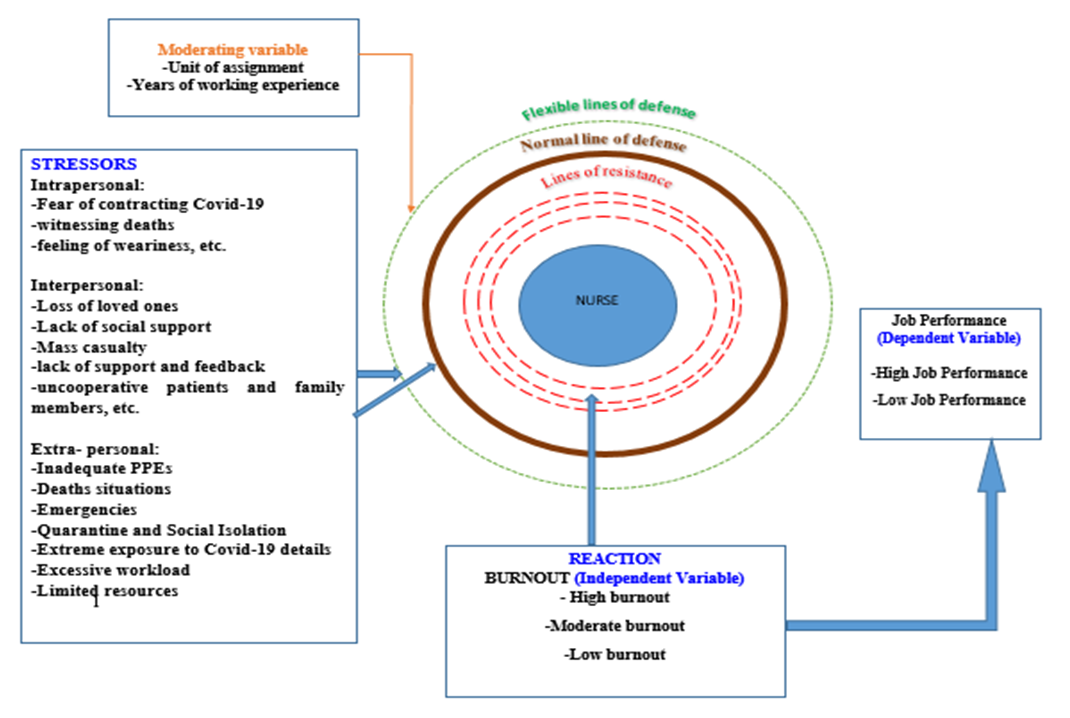
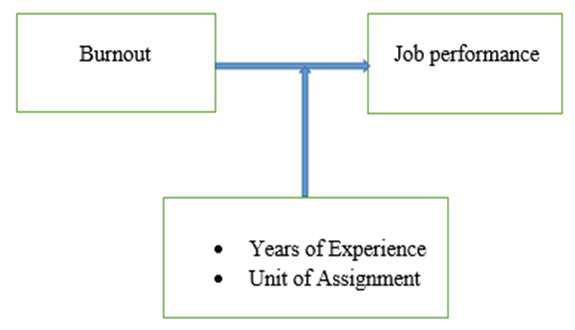
 Abstract
Abstract Reference
Reference Full-Text PDF
Full-Text PDF Full-text HTML
Full-text HTML